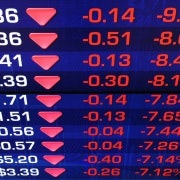Sidestepping Australia's unsustainable assets
There are a variety of converging risks that could erode or destroy the value of polluting and environmentally unsustainable assets in Australia and almost everywhere else. These range from climate change, through to new environmental regulations, developments in clean energy technologies, resource limits, evolving public opinion, and litigation.
These current and emerging risks represent a major discontinuity, able to profoundly alter asset values across a wide range of sectors. As these environment-related risks materialise they could result in stranded assets, where assets suffer from unanticipated or premature write-downs, devaluations, or become liabilities. This could have significant implications for investors beyond the business-as-usual creative destruction we see in market economies day-to-day - we will see more technologies like Betamax and many more companies like Kodak.
At-risk assets exist throughout our financial and economic systems, from coal-fired power stations to certain types of farmland, and there could be a significant over-exposure to such risks within current investor portfolios. Yet at present, these risks are likely to be fundamentally mispriced and misunderstood by investors and the investment chain.
The vast majority of asset owners, asset managers, banks, investment consultants, actuaries, accountants, equity analysts, credit ratings agencies, lawyers, and regulators – not to mention the companies involved – don’t yet have the tools or expertise to appreciate environment-related risks and manage them in any meaningful way. Quite simply, these are not the kind of things that investment committees or pension fund trustees currently tend to care about or question.
This will change, and could change quickly. Some of the agents involved are beginning to see that such risks could be material over meaningful time horizons – in other words that they could be revealed in the short to medium term and aren’t just very long term risks that can be put to one side indefinitely. There are already many significant examples of how assets have been stranded by environment-related risks and then hit investor returns – for example: renewable energy depressing power prices and negatively impacting incumbent utilities in Europe; the emergence of shale gas stranding coal assets in the US; water constraints stranding coal assets in South Asia; or droughts stranding sun seed processing facilities in Spain.
Australian assets most obviously at risk in the near term could be coal mines with high extraction costs. Softening demand for coal from China due to structural economic change (less investment and more consumption), combined with consistently impressive renewables growth, sickening air pollution, massive efforts to improve energy efficiency, and severe water stress, will all reduce demand relative to the outdated forecasts used by some miners. Pure-play coal miners with projects like Alpha Coal and China First will be most at risk.
At Oxford University’s Smith School of Enterprise and the Environment we have begun a research programme to understand these risks. One of the emerging conclusions from the work completed so far is that these risks are likely to be interrelated and this could result in a domino effect. For example, the fossil fuel divestment campaign building momentum in university campuses, particularly in the US, could increase the chance of carbon pollution regulation being introduced, thereby stranding some carbon-intensive assets.
Our work also looks at how the way we value assets might change, thereby stranding assets. It might be reasonable to think that new valuation frameworks, norms, and approaches to valuation might emerge in response to the financial crisis or the challenge of environmental sustainability. These new approaches could influence future capital allocation, as well as corporate strategy, which could then affect investors.
Investors can take some no-regrets steps to manage these possible developments and promote reform. Here are five to start with that investors, in Australia and internationally, should adopt:
First, monitor exposure to assets that might be at risk. The companies that could be affected comprise a surprisingly large variety of sectors and markets.
Second, stress test portfolios against potential risks using a range of scenarios. Assets unable to withstand these scenarios and the internalisation of environmental costs should be much more closely monitored.
Third, engage with companies that you have invested in. Considerable communication with management can be undertaken to influence behaviour so that companies better manage these risks.
Fourth, hedge risk exposure and weight portfolios in favour of assets less likely to be at risk.
Fifth, work on and support others working on the development of frameworks and tools that help investors to understand and quantify such risks. There is much to do and all parts of the investment chain need to be involved.
Ben Caldecott is the director of the Stranded Assets Programme at Oxford University’s Smith School of Enterprise and the Environment.













